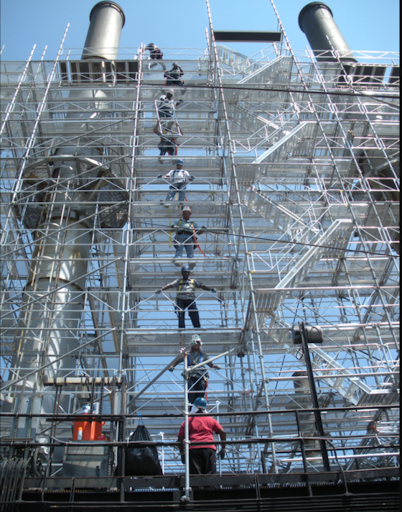Choosing a Local Scaffolding Company for Reliable and Timely Service
Choosing a Local Scaffolding Company for Reliable and Timely Service
Blog Article
Discovering the Benefits of Scaffolding for Contractors and Construction Employees
The execution of scaffolding in building and construction jobs offers as a vital component for boosting operational effectiveness and security. The full range of scaffolding's benefits expands past mere functionality and security-- there are deeper effects that necessitate further exploration.

Improved Employee Security
Improved worker safety and security is an extremely important problem in the building and construction sector, especially when it concerns the use of scaffolding. Correctly designed and mounted scaffolding systems supply important support for workers running at elevations, substantially minimizing the danger of drops, which are among the leading root causes of casualties in building and construction.
Scaffolding improves safety via its architectural stability and design attributes that permit steady job platforms. High-quality scaffolding products, such as steel or light weight aluminum, deal durability and toughness, making certain that they can stand up to the weight and movement of materials and workers. In addition, security measures such as guardrails, toe boards, and access ladders are essential elements that avoid accidents and injuries.
Regular inspections and upkeep of scaffolding are essential to copyright security requirements. Investing in proper scaffolding solutions is not just a governing need; it is an essential element of promoting a secure functioning setting in the building and construction market.
Enhanced Availability
Ease of access in the construction industry is important for promoting performance and performance on task sites. Scaffolding offers a versatile remedy that dramatically boosts availability for specialists and building workers. By offering secure platforms at various elevations, scaffolding allows employees to get to elevated locations safely and properly, minimizing the need for difficult ladders or uncomfortable positions that can prevent development.
The design of scaffolding systems enables simple motion of workers, devices, and materials, improving operations and reducing hold-ups. With proper scaffolding in position, employees can work together better, as numerous staff member can run simultaneously in a constrained space without jeopardizing safety and security or ease of access. This flexibility is particularly important in intricate construction projects that need regular changes in height or setting.
Moreover, scaffolding can be tailored to fit particular job requirements, making certain that all locations come despite the structure's style. By boosting accessibility, scaffolding not only improves the job environment but also contributes to a much more orderly website, therefore advertising a culture of efficiency and safety. In summary, improved availability via scaffolding is a crucial aspect in maximizing the efficiency of construction groups.
Enhanced Effectiveness
The application of scaffolding not just boosts access but also plays a significant role in enhancing effectiveness on construction sites. By supplying a safe and secure and secure system, scaffolding permits employees to do jobs at height with better ease and safety. This decreases the time invested moving products and tools, as whatever needed is within arm's reach. Employees can concentrate on their particular tasks without frequent disturbances.
Moreover, scaffolding makes it possible for multiple professions to function all at once, boosting cooperation and accelerating project timelines. While one team is installing electric systems, another can function on pipes or finishing jobs on the very same level, lessening downtime. The calculated design of scaffolding likewise assists in quicker motion across the website, eliminating the requirement for constant elevation modifications or extreme ladder usage.

Cost-Effectiveness
While many may originally regard scaffolding as an added expenditure, its execution in fact adds to substantial cost-effectiveness on building projects. By helping with safer and much more reliable work atmospheres, scaffolding minimizes the dangers of injuries and accidents, which can bring about expensive delays and increased insurance policy costs.
Moreover, scaffolding boosts productivity by providing workers with immediate access to multiple levels of a structure. This ease of access not just increases the pace of construction but likewise reduces labor costs, as employees can complete tasks a lot more quickly without the requirement for cumbersome ladders or lifts.
In addition, the modular nature of scaffolding permits adaptability in its use across various projects, resulting in minimized rental expenses when contrasted to much less adaptable options. The capability to recycle scaffolding for various tasks additionally intensifies its cost-effectiveness, making certain a greater return on financial investment.
Versatility in Applications
Frequently identified for its flexibility, scaffolding offers a vast array of applications in the building and construction sector. Its adaptability permits usage in different jobs, from domestic buildings to large-scale business growths. Scaffolding systems can be personalized to fit different site conditions, suiting distinct architectural designs and heights.
In addition to standard construction, scaffolding is additionally vital for repair and maintenance jobs. Whether it entails painting, window installation, or exterior repair, scaffolding offers a stable system that improves scaffolding software employee security and efficiency. Its modular layout enables quick setting up and disassembly, making it suitable for jobs with limited timelines.
Moreover, scaffolding is not restricted to vertical frameworks; it can be successfully utilized in bridge building and construction, industrial centers, and even temporary event rooms. The ability to adjust scaffolding for different settings guarantees that contractors can satisfy varied job requirements without jeopardizing safety and security or availability.
This multifunctionality underscores the value of scaffolding in modern building techniques, allowing service providers and construction employees to implement their tasks with higher adaptability and precision. Eventually, the convenience of scaffolding contributes substantially to the total success of construction jobs throughout numerous industries.

Conclusion
In summary, the benefits of scaffolding for service providers and building and construction employees are considerable. Improved worker safety minimizes fall threats, while boosted availability guarantees that elevated areas can be reached easily. Enhanced efficiency is achieved via smooth process, and cost-effectiveness is recognized by optimizing source appropriation. The adaptability in applications enables scaffolding to adapt to different job needs. Collectively, these advantages contribute to a safer, extra efficient, and economically feasible building setting.
The implementation of scaffolding in building and construction projects offers as a vital component for improving functional effectiveness and security. Scaffolding provides a flexible remedy that considerably boosts ease of access for service providers and construction employees. In recap, enhanced availability via scaffolding is a vital variable in optimizing the efficiency of building and construction teams.
The application of scaffolding not only scaffolding tower enhances access but likewise plays a substantial duty in increasing effectiveness on building and construction websites. Temporary Roof Scaffolding.In recap, the advantages of scaffolding for professionals and building employees are significant
Report this page